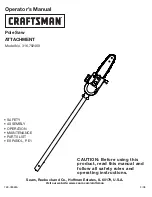
Persons under the age of 18
must not operate the circular
saw. An exception is
youngsters under the age of 16
within the scope of their
vocational training under
supervision.
Keep
other persons
away.
Do not allow other persons, especially
children
, to
touch
the
tool
or
cable
.
Keep them away from your working area.
Take up a
working position
, in which you are always to the
side of the saw blade outside of the cutting level.
Only begin cutting when the saw blade has reached the
required speed.
Do not overload the machine! You work better and safer in
the
given performance range.
Only operate the machine with complete and correctly
attached
safety equipment
and do not alter anything on the
machine that could impair the safety.
Do not used cracked saw blades
or those that have
changed shape.
Only use well
sharpened
saw blades, as blunt saw blades
not only increase the
risk of throw-back
errors, but also
load the motor.
Do
not use saw blades made of high-alloy high-speed
tool steel
(HSS), because this steel is hard and brittle, only
tools in accordance with EN 847 – 1 may be used.
The use of
other tools
and other accessories can
signify a
risk of injury
for you.
Use the
installed splitting wedge
. It is set in the works so
that its distance from the toothed ring
above the table must
not be more than 5 mm.
Do not use the saw for unsuitable purposes (see 'Normal
intended use').
When longitudinally cutting
narrow workpieces
(distance
between the saw blade and the parallel rip fence less than
120 mm), use the
pushstick.
(see working instructions).
To push narrow workpieces against the parallel rip fence,
use a
pushstick
.
Î
Pushsticks can be purchased in retail outlets.
Do
not use defective
pushsticks.
The upper
saw blade guard
must always be used. It must
be adjusted so that the
toothed ring
is covered except for
the part required for machining the workpiece.
Ensure that
cut off pieces
are not caught up by the saw
blade and projected away.
Do not remove splinters, chips and waste from the
hazardous area of the saw blade by hand.
It is not permissible to use
wobble devices
and
groove
milling tools.
Cutting logs with the standard feed guides is not permissible.
When cutting logs, use a special device
, which secures
the workpiece on both sides of the saw blade against
turning.
Switch the machine off and
remove the mains plug from
the socket
when
−
carrying out repair works
−
carrying out servicing and repair works, removal of faults
(this also includes removing clamped splinters)
−
Transporting the saw
−
Changing the saw blade
−
leaving the saw unattended (even during short
interruptions)
Look after
your saw with care:
−
Keep the
tools
sharp and clean to be able to work better
and more safely.
−
Follow the
servicing instructions
and the information
about changing tools.
−
Keep
handles
dry and free of oils and grease.
Check the machine for possible damage:
−
Before continuing to use the machine, the
protective
devices
must be inspected to ensure that they work
perfectly and with their intended function
−
Check whether the
movable parts
function perfectly and
do not stick or whether the parts are damaged, All parts
must be correctly installed and fulfil all conditions to
ensure perfect operation of the saw
−
Damaged guards
and parts must be properly repaired or
exchanged by a recognized, specialist workshop; insofar
as nothing else is stated in the instructions for use.
Do not allow any tool key to be plugged in!
Store the
unused machine
in a dry locked place away from
the reach of children.
Electrical safety
Design of the
connection cable
according to IEC 60 245
(H 07 RN-F) with a core cross-profile section of at least
−
1.5 mm2 for cable lengths
up to
25m
−
2.5 mm2 for cable lengths
over
25m
Protect yourself against an
electric shock
. Avoid touching
earthed parts with your body.
Do not use the
cable
for purposes for which it is not meant.
Protect
the cable against
heat, oil and sharp edges
. Do
not use the cable to pull the plug from the socket.
Regularly check the saw cable
and if damaged, have it
renewed by a recognised skilled electrician.
Regularly check the
extension cable
s and replace them if
they are damaged.
Do
not use any defective connection cables.
When working outdoors, only use extension cables
especially
approved
and appropriately labelled for outdoor
use.
Do
not set up any provisional
electrical connections.
Never bypass
protective devices or deactivate them.
The
electrical connection
or
repairs
to electrical parts of
the machine must be carried out by a certified electrician or
one of our customer service points. Local regulations –
especially regarding protective measures – must be
observed.
20
Содержание T 250 -
Страница 78: ...77...
















































